Before I get into the meat and potatoes of this article I want to take a moment to talk about why I was so drawn to this topic in the first place. For me it all comes back to the process of evolution we all go through as anglers. Everyone, from the “once a year” participant to the diehard that spends every waking moment obsessing about their next cast, next big fish or dreamed of destination, they all go through a similar growth process as a player in this sport. It is worth pointing out that those operating at the extremes, those most seriously afflicted with what is an incurable fishing bug, often go through this evolution at a much accelerated pace! But nonetheless, the irrefutable similarities are there.
So what is this evolutionary process? I don’t want to bog down the entire article by delving too deeply or spending too much time untangling every nuance of this part of the story. So allow me to be excessively brief in an effort to keep things moving along.
In the beginning an angler just wants to catch fish. They don’t want to understand the mechanics of making it happen, the environmental factors that play into fish location or lure choice. All the angler wants early on in their evolution is for a fish to bite, the pole to bend and the drag to slip, if only just a little. Many anglers move through this stage with an almost imperceptibly slow pace, lingering at what is the very beginning of the process.
Others can’t help but ask questions and this singular act sets the wheels turning and the process in motion.
Why are we fishing HERE? Why do some species bite better on windy or overcast days? Why am I using this lure and could I be using something that would work better?! From that moment on the angler embarks on a journey with no finish line in an attempt to understand what it takes to consistently catch a fish.
One of the next steps is to not only catch a fish, any fish, but a favored target species.
Shortly thereafter preferred fishing methods develop. At this point not only is it not enough to catch a fish, but that fish needs to be a preferred species and landed using a favorite fishing presentation.
There are many forks in the road along the way and at this point in the evolution anglers often diverge in myriad directions for varying periods of time. Some become trophy hunters, others focus on refining their prowess with a singular species while some devout considerable time to sharing their knowledge of fishing with others.
So that brings us back to the actual topic of this article. It is my belief that to truly understand and appreciate Tom “Crappie Tom” Sawvell, you need to have perspective on his evolution as an angler and how he came to be a bit of a mad-scientist type cranking out highly sought after custom soft plastics in his basement. For all the Breaking Bad fans out there, perhaps a better way to put it might be to imagine NOT knowing that Walter White was a high school chemistry teacher. See how it changes the story? Plus Tom dons a wicked-cool apron when working in his “lab” and wears long rubber gloves when “cooking” so I think my comparison holds water.
When I asked the obligatory question, “how did you ever start making tackle?” Tom responded by detailing the meandering path he’d taken as an angler to get to where he is today.
When Tom was in elementary school, like many of us, he was enthralled with anything and everything to do with the outdoors. Fortunately for him, Tom’s neighbors were avid anglers and provided him with some initial exposure to the sport as well as some mentoring during his formative years.
Shortly thereafter Tom was given an outdated Herter’s catalog that would play a pivotal role in what would come next. For those not familiar, in its day the Herter’s catalog sold just about anything and everything even loosely related to hunting and fishing, including equipment and supplies needed to make fishing lures. It was in this particular catalog, with its yellowed and torn pages, that Tom spotted a section for flying tying essentials that would forever change his course.
It didn’t take long behind the vice to realize Tom was a natural. By the time Tom entered the 7th grade a few teachers, who were also avid fly fisherman, took notice of Tom’s exceptional creations. Within a few months of being discovered Tom was doing quite well for a junior high student with a hobby, making 49-cents a fly.
At this point In the story, Tom leaned off the bench and informed me that 49-cents a fly “would be like making $5 to $10 today.” His reputation kept growing and fly anglers from around Southeast Minnesota were seeking him out.
When Tom reached high school, it turned out his Industrial Technology teacher had a similar passion for fishing and the two decided they wanted to begin pouring jigs. This would, of course, require a mold be made. To get their project up and running meant the up-start jig makers would need to create their own as there was no such thing as off-the-shelf molds in those days. I could tell Tom was still pretty proud of this accomplishment as he added in at the end, “It was pretty dang nice, even had hinges!” In today’s day and age getting into jig making is a far cry easier than it was back in the day with companies like Do-It Molds offering ready-made multi-cavity molds that can be purchased online with the click of a button. At this point I think it worth mentioning that I’ve added links to many of the ingredients used in this article so the readers can familiarize themselves with the basics if they’re so inclined.
I was looking at my notes trying to find my next question when Tom decided to take matters into his own hands. “Enough of this”, Tom abruptly spouted! “Let’s get down to business!”
Tom started my plastic pouring education by pointing out that the process “just isn’t as complicated as people might think.” At that very moment I remember looking around at an almost endless collection of bottles full of glitter, plastic, molds and other equipment that seemed to prove otherwise. Thankfully Tom got my attention back on track with an outstretched arm and pointing finger, “You see that microwave over there? That’s where we’ll start.”
We started by using a few pre-mixed colors, as he threw a bowl into the microwave. “Never, ever do you want to burn the plastic, it’s the easiest way to ruin the whole thing!” As good teachers will often do, he began my education by showing me what not to do. After heating the bowl for a couple minutes too long the seemingly clear plastic came out as a yellow tainted, ugly mess. Check. Don’t burn the plastic. Got it.
Another point Tom made abundantly clear was that controlling temperature was the first key in pouring plastics. When it came time to check temperature on the next batch of molten plastic coming out of the microwave Tom did his best Walter White impersonation and whipped out one of his most relied upon tools – the infrared thermometer. After a quick test the read-out showed 343 degrees which was a few degrees short of the intended temperature of 350 degrees. “Ten more seconds “should get us where we need to be,” Tom said with a nod.
While the microwave was working its radiative magic in an attempt to bring the plastic up to temperature, Tom readied the mold and offered this insight, “the biggest advancement for the do it yourself types that want to mold their own baits is the availability of off the shelf molds that just weren’t available 5 years ago.” A quick look around online proved Tom was dead right. Companies like Do-it Molds offer molds for just about any commercially made bait you can think of from craws to creatures to worms and everything in between. And the costs of those molds continue to drop. “Today, the only limitation you’ll have when it comes to making your own baits is your creativity!”
Once the plastic was heated to the proper temperature and removed from the microwave Tom go serious with his movements. The mold was at the ready, plastic was “sucked” up out of the bowl and into a plastic injector that looks like a cross between a gigantic hypodermic needle and a turkey baster which he used to inject the the molten plastic into the mold. After a quick cool-down to allow the plastic to set up Tom opened the mold and triumphantly produced four chartreuse ringworms in pristine condition. “Well, there you have it! Now you know everything there is to know about making your own softbaits,” he said with a sly smirk.
I will say, it did look easy enough. But I’m also familiar with the idea that talented people make the difficult look easy. Now I’m not saying hand-pouring plastics is out of the reach of the average Joe. It most certainly isn’t. But I’m willing to bet my learning curve had been shortened considerably through the brief amount of time I had spent watching the master at work.
The next step for Tom, and this is likely the case with all his creations, is customization. Tom picked up one of those pristine chartreuse ringworms and quickly lopped off the tail. “Now begins the fun part,” he cackled as he bellied up to his bench and started pulling together yet another batch of ingredients. “What’s your favorite walleye color?” he asked. I instinctively responded with “Firecracker Chartreuse” without even giving the question proper time to sink in.
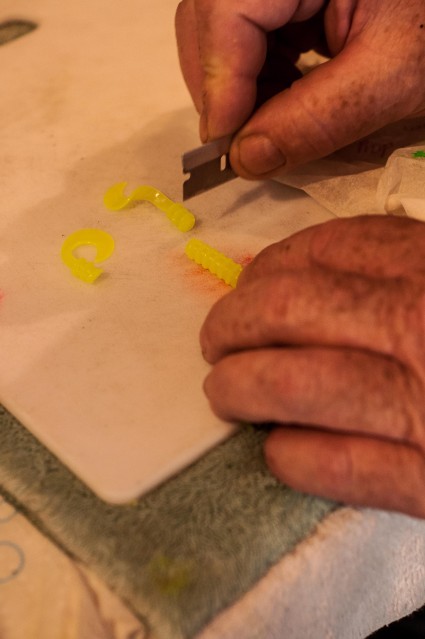 His hands made quick work as we had a conglomerate of ingredients at the ready. A little plastisol, a touch of softener, a little stabilizer, and of course the headlining ingredients needed to make any proper Firecracker soft plastic – red and blue glitter! One would think glitter would be pretty standard, but that’s definitely not the case if you take your hand pouring of plastics as serious as Tom! He dug through countless boxes of glitters until he found the perfect red and blue in just the shade he desired, and in the correct size of 0.4 mm. Not too big. Not too small. But just right.
His hands made quick work as we had a conglomerate of ingredients at the ready. A little plastisol, a touch of softener, a little stabilizer, and of course the headlining ingredients needed to make any proper Firecracker soft plastic – red and blue glitter! One would think glitter would be pretty standard, but that’s definitely not the case if you take your hand pouring of plastics as serious as Tom! He dug through countless boxes of glitters until he found the perfect red and blue in just the shade he desired, and in the correct size of 0.4 mm. Not too big. Not too small. But just right.
I remember thinking to myself as Tom hunted and pecked through his collection of shiny tid-bits that “no man should ever own this much glitter.” In Tom’s case, considering the finished product, I’ll let it slide.
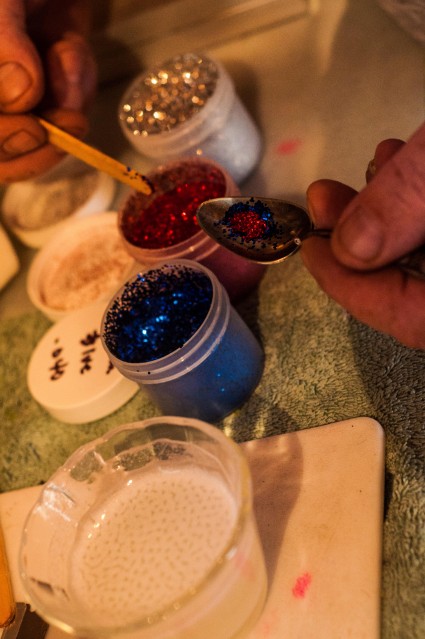 With the glitter added to the mixture Tom was ready to create his masterpiece. Quick hands made short work with the injector and firecracker mixture coursed through the mold. After a very brief cooling period the clamps on the mold were released and out popped an exact replica of the firecracker chartreuse ringworm that I had envisioned. But it seemed noticeably better! Upon closer inspection I noticed the plastic was softer than anything I had ever held in my hands and when I moved it for inspection the body almost seemed like it wanted to keep moving as if on its own. This would clearly be an advantage as this bait would undoubtedly have more action in the water. And the colors were incredible as well. Bright and vibrant with just the perfect amount of glitter to catch the light! It was in that moment that I found my true appreciation for hand pouring baits. Hand pouring isn’t about creating vast quantities of baits, its about creating the very best bait possible in exactly the shape and color patterns YOU desire!
With the glitter added to the mixture Tom was ready to create his masterpiece. Quick hands made short work with the injector and firecracker mixture coursed through the mold. After a very brief cooling period the clamps on the mold were released and out popped an exact replica of the firecracker chartreuse ringworm that I had envisioned. But it seemed noticeably better! Upon closer inspection I noticed the plastic was softer than anything I had ever held in my hands and when I moved it for inspection the body almost seemed like it wanted to keep moving as if on its own. This would clearly be an advantage as this bait would undoubtedly have more action in the water. And the colors were incredible as well. Bright and vibrant with just the perfect amount of glitter to catch the light! It was in that moment that I found my true appreciation for hand pouring baits. Hand pouring isn’t about creating vast quantities of baits, its about creating the very best bait possible in exactly the shape and color patterns YOU desire!
I know Tom could almost see the gears grinding in my head, when he said, “Ben, this can be as easy or as hard of a hobby as you want it to be.” He went on to explain how easy it can be to do, and how his “hobby” was the exception rather than the norm. He offered some incentive, tips and ideas for a first timer to get into the ballgame.
The first would be the cost savings, once you get past the initial investment your soft plastics become significantly less expensive. Where a homemade plastic costs about $.03, a store bought one would cost around $.40 to $.50 a piece! That’s that kind of savings that can add up quickly if you fish soft plastics extensively.
One of the other benefits, I believe Tom felt strongly about was the act of creating something unique. For example, if there is a strong Emerald Shiner run going down on the Rainy River and the walleye are keyed in on this one food source, you can pour the exact coloration found on the shiners. Having the ability to mimic almost any bait fish found in nature by being able to manipulate softness, color and texture is undoubtedly an invaluable advantage. Plus catching fish on a bait of your own creation is incredibly satisfying!
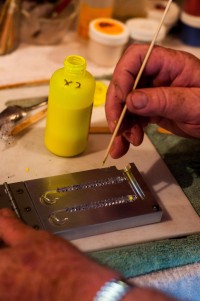 With the number of river anglers that frequent In-Depth Outdoors my gut tells me there’s a lot of potential interest in making hand pour baits. And it just isn’t as daunting a process I as expected going into my time spent with Tom. For those just getting started or for anyone that has questions about the hand pouring baits, or making tackle in general, Tom has offered to answer questions that people might have – a true asset to In-Depth Outdoors! Tom has started a new group here online called “Jig Casting & Plastic Injection.” Be sure to stop in and chat with Tom. If you have any questions for the master, this new group is the place to get them answered.
With the number of river anglers that frequent In-Depth Outdoors my gut tells me there’s a lot of potential interest in making hand pour baits. And it just isn’t as daunting a process I as expected going into my time spent with Tom. For those just getting started or for anyone that has questions about the hand pouring baits, or making tackle in general, Tom has offered to answer questions that people might have – a true asset to In-Depth Outdoors! Tom has started a new group here online called “Jig Casting & Plastic Injection.” Be sure to stop in and chat with Tom. If you have any questions for the master, this new group is the place to get them answered.
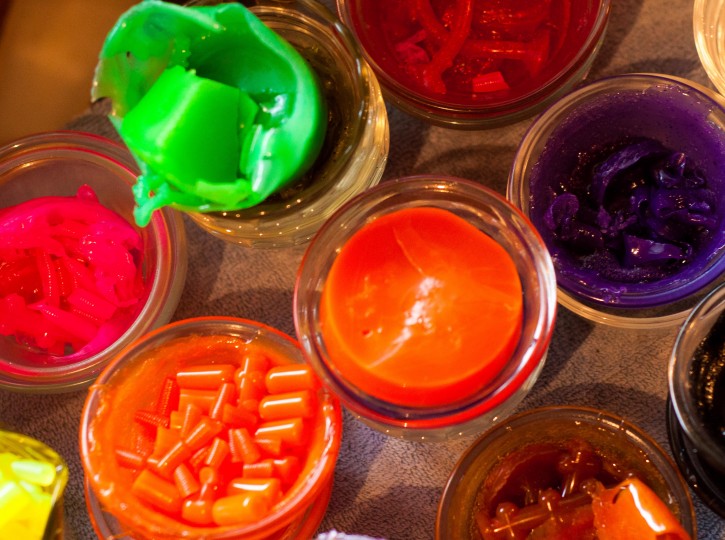
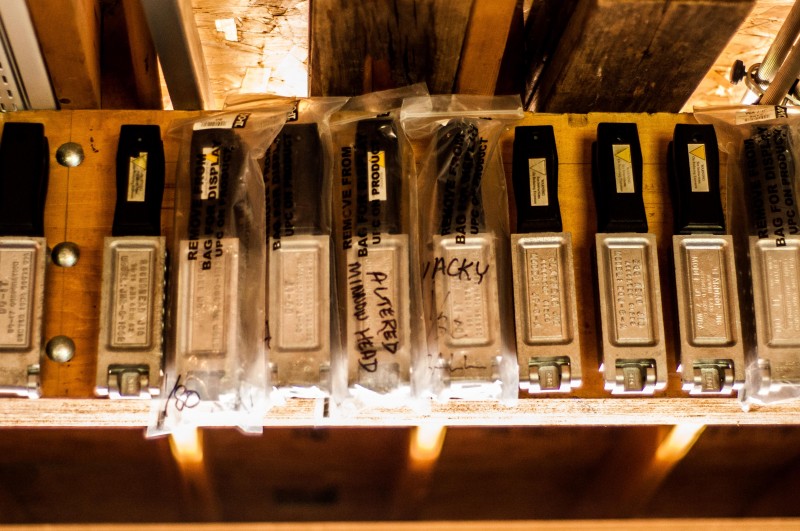
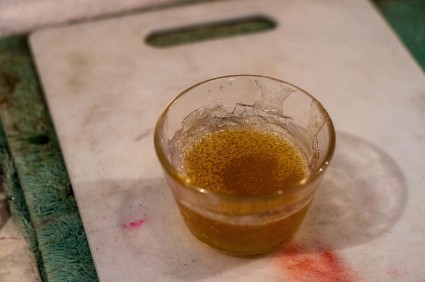
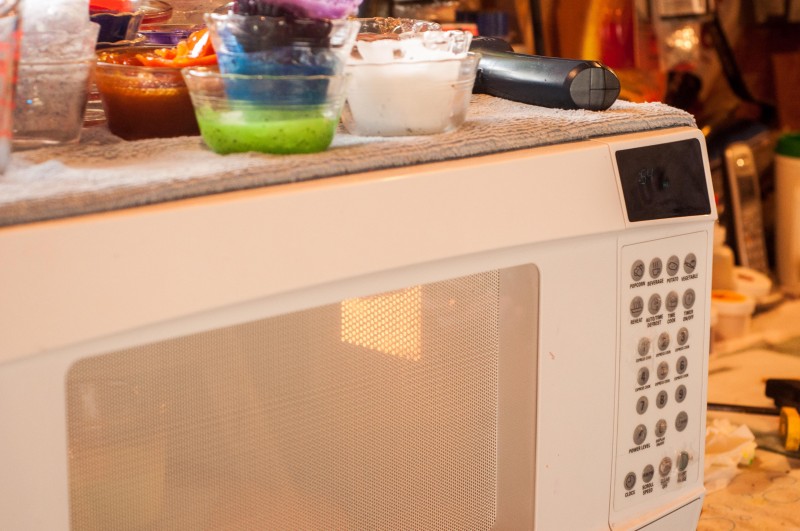
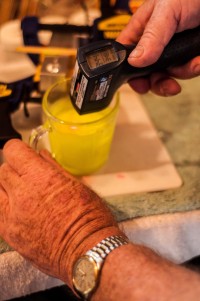
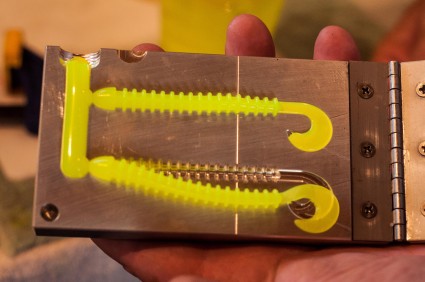
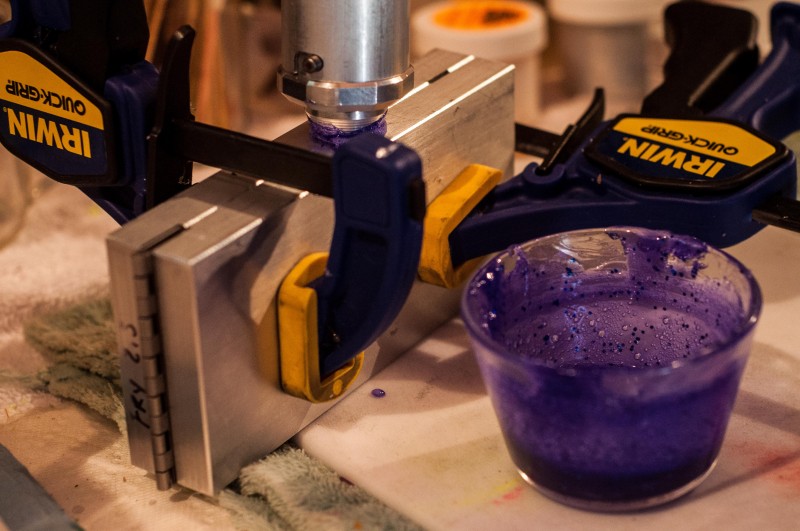
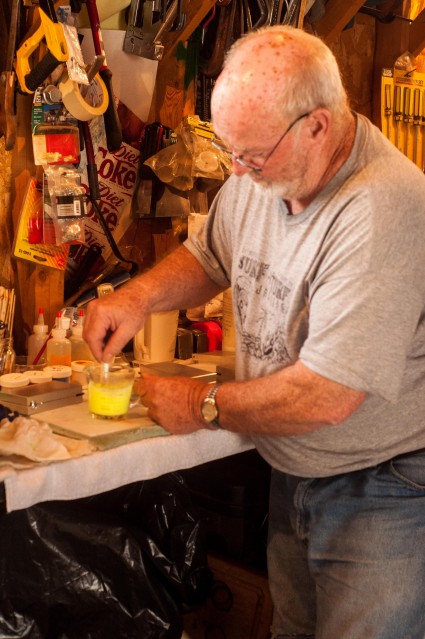
Love the article. That man knows his stuff and produces amazing plastics.
Very cool ! Never would have thought a microwave would play a role in plastics !
Great article. I met Tom years ago and have even had the pleasure of fishing with him for walleyes and crappies, with plastics, jigs, and other various tools of his own creation. The man is a seasoned veteran of the woods and water, and it’s neat to see someone so dedicated (and proficient) in their craft. I’ve learned lots from Tom over the years, which is why it’s so cool to see this article as just a glimpse into what makes him “Crappie Tom.”
Joel
There are some that saw the “Creepy Crawler” maker of the ’60’s as a toy. CT’s light bulb went off when he saw them!
I read it twice!
PS Tom’s wife makes some awesome jalapeño Jelly!
My crappie box is full of Tom’s handiwork. I love the color combos and the softness of his plastics. Some are shapes and colors not found in stores. Good times fishing with his plastics.
I also have some of Toms baits and they are very unique and not to be found anywhere else! Great story Ben!